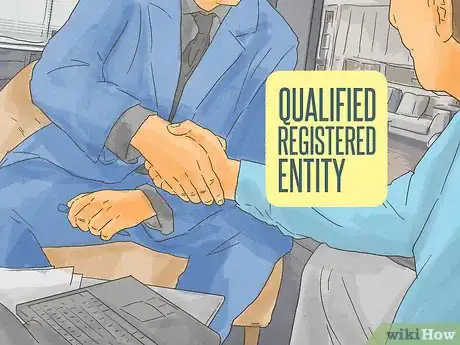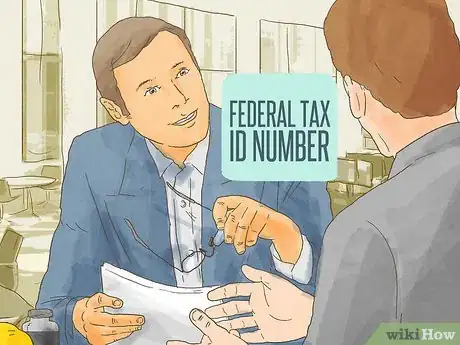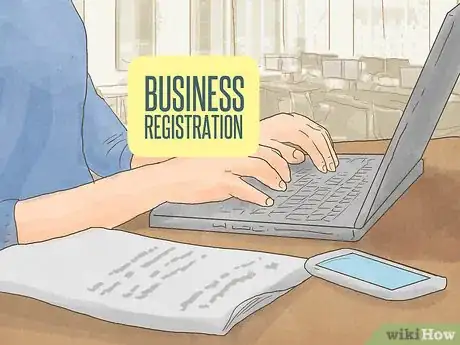This article was co-authored by Clinton M. Sandvick, JD, PhD. Clinton M. Sandvick worked as a civil litigator in California for over 7 years. He received his JD from the University of Wisconsin-Madison in 1998 and his PhD in American History from the University of Oregon in 2013.
There are 18 references cited in this article, which can be found at the bottom of the page.
This article has been viewed 65,578 times.
When you create a business in Texas, you have the opportunity to choose from multiple business structures including for-profit and nonprofit corporations. You can incorporate in Texas by naming your company, choosing a registered agent, selecting board members and filing a Certificate of Formation. In addition, if you have already incorporated in another state but wish to do business in Texas, you may have to register your foreign corporation with the state.
Steps
Choosing a Business Structure
-
1Consult an attorney. The process of choosing a business structure can be complicated and daunting. However, with the help of an attorney, you will be able to talk about what you expect your corporation to do and how you want to run your business and in return the attorney will be able to advise you on different structures.
- To find a qualified business attorney, ask your friends and colleagues for a recommendation. A lot of people deal with business attorneys through their jobs and through their personal dealings. If they know one, they should be able to tell you about what they liked and didn't like about their experience.
- If you are having trouble finding a recommendation, visit your state's bar association and use their lawyer referral service or search database. Using these tools, you should be able to find a well qualified and honest attorney to help you with your decisions.
-
2Decide how you want your business to operate. Before you incorporate you will want to discuss how you want to run your business. Would you like to have passive owners (i.e., passive shareholders) or would you like to have member-managers (common in nonprofits)? Would you like the purpose of your organization to be charitable or something more commercial? These are just some of the questions you should contemplate before starting the incorporation process.Advertisement
-
3Think about where you would like to incorporate. You do not need to incorporate in Texas in order to transact business in Texas. You can choose to incorporate in any state you want to. Whichever state you choose to incorporate in is the state whose law will govern your corporation. However, if you do not incorporate in Texas and you want to transact business in Texas, you will have to register your foreign corporation.
-
4Determine how you will use your business's profits. If you want to distribute your profits to shareholders and employees in the form of dividends and bonuses then you might want to consider creating a for-profit corporation. If, however, you want to take profits and put them back into your business or use them for charitable purposes, then you may want to use a nonprofit corporate structure.
Forming a For-Profit Corporation
-
1Name your corporation. Texas law requires that your corporation have a business name. Once you come up with a name, you should trademark it in order to protect its value. To trademark a name you will visit the federal government's Patent and Trademark Office website, fill out the required forms, and file them online with the applicable fees.[1] The name you choose must meet the following requirements:
- The name must include one of the following words or an abbreviation thereof: "company," "corporation," "incorporated," or "limited."
- The name cannot be deceptively similar to the name of another existing or registered business entity in Texas or a name that has been reserved by a business entity in Texas.[2]
- You may reserve a name for 120 days by filling out an Application for Reservation (Form 501) or Renewal of Reservation of an Entity Name (Form 505) and paying a $40 fee. You can reserve a name online at http://www.sos.state.tx.us/corp/sosda/index.shtml or by completing Form 501 located at http://www.sos.state.tx.us/corp/forms/501_boc.pdf.
-
2Appoint directors. Directors (or the board of directors) are the people responsible for managing the business of the corporation. Talk with possible candidates and ask if they would be willing to act as a director. If you find one or more directors, you will use their names and other personal information when you prepare your certificate of formation.
- Texas requires that corporations have one or more directors.
- There is no minimum age requirement for directors.
- Texas law does not require directors to be residents of Texas or shareholders of the corporation. However, the corporation’s bylaws or certificate of formation may require it.[3]
-
3Choose a registered agent. Texas requires corporations to maintain a registered agent in the state. A registered agent is an individual Texas resident, a domestic entity, or a foreign entity that has qualified or registered to transact business in Texas and who is responsible for receiving and forwarding service of process or official notices addressed to a corporation. entity.[4]
- Find someone who is willing to take on this duty and let them know you will be using their name.
-
4Prepare a certificate of formation. In order to incorporate in Texas, your business must prepare a certificate of formation (Form 201). You can download the form at http://www.sos.state.tx.us/corp/forms/201_boc.pdf. If you are going to file online, you do not need to download Form 201 but you will need to prepare all the necessary information. The form must include the following:
- The name and type of entity being formed;
- The names and addresses of directors and registered agents;
- The number and value of initial authorized shares;
- The business purpose for which the entity is being formed;
- The name and address of the organizer (i.e., the person responsible for incorporating the company);
- The effectiveness of the filing, which means when you want the document and the entity to become effective; and
- The signature of the organizer.[5]
-
5File your certificate of formation. Once you have prepared your certificate of formation, it must be delivered to the Secretary of State in person or by mail, courier, facsimile or electronic transmission, or any other comparable form of delivery.[6] When you file you will also be required to pay a filing fee of $300.[7]
- To file online, you will use Texas' Secretary of State website (SOSDirect) at http://www.sos.state.tx.us/corp/sosda/index.shtml.
- If you are faxing your filings you can fax them to the number found on the Secretary of State's website.[8]
-
6Create bylaws. While Texas does not set out any concrete requirements for a corporation's bylaws, they should usually contain information about internal rules and procedures, responsibilities of officers, the size of the board, how shareholder meetings will be held.[9]
- You don't have to file these bylaws with the Secretary of State but Texas law requires you keep this document at your main office.[10]
- You can also look up sample Texas bylaws in order to get an idea of what should be included.
-
7Request an Employer Identification Number (EIN). Texas requires that you have an EIN, also known as a federal tax identification number, which is used to identify businesses for tax purposes.
- You can apply online for an EIN at https://www.irs.gov/businesses/small-businesses-self-employed/how-to-apply-for-an-ein.
-
8Maintain corporate records. Texas corporations are required to maintain the following information:
- Books and records of accounts;
- Meeting minutes for director, owner or member meetings; and
- A current record of the name and mailing address of each owner or member of the corporation.[11]
-
9Comply with tax requirements. Corporations formed in Texas may be subject to a variety of taxes, including:
- Franchise tax;
- State sales tax;
- Federal income tax; and/or
- Federal employment tax.
Creating a Nonprofit Corporation
-
1Create a name. Texas law requires that your corporation have a business name. Once you come up with a name, you should trademark it in order to protect its value. To trademark a name you will visit the federal government's Patent and Trademark Office website, fill out the required forms, and file them online with the applicable fees.[12] Your nonprofit organization's name does not have to contain "Inc.", "Ltd.", "Incorporated", or "Company".
- The name cannot be deceptively similar to the name of another existing or registered business entity in Texas or a name that has been reserved by a business entity in Texas.[13]
- You may reserve a name for 120 days by filling out an Application for Reservation (Form 501) or Renewal of Reservation of an Entity Name (Form 505) and paying a $40 fee. You can reserve a name online at http://www.sos.state.tx.us/corp/sosda/index.shtml or by completing Form 501 located at http://www.sos.state.tx.us/corp/forms/501_boc.pdf.
-
2Prepare your certificate of formation. Your certificate of formation is the document you will file with the Secretary of State that will form your nonprofit. When you are forming a nonprofit you will use the Secretary of State Form 202.[14] Your certificate of formation needs to include the following:
- A purpose clause, which will define the charitable purpose of your nonprofit corporation;
- IRS language, which needs to be included in order to get federal tax-exemption and deals with inurement and dissolution;
- The names of initial directors, which in Texas there must be a minimum of three;
- The name of the incorporator who signs the certificate;
- The name and address of a registered agent who will receive all official business correspondence; and
- The names of members.
-
3File your certificate of formation. After preparing your certificate of formation you will need to file it with the Secretary of State. It can be filed in-person, through the mail, through fax, or online. If you are filing online you can use the SOSDirect website.
- When you file you will be required to pay a $25 filing fee.[15]
-
4Prepare bylaws. Your initial board of directors should create a set of bylaws and one will be necessary if you are filing for federal tax exemption. The bylaws should contain information about:
- Meetings;
- Leadership;
- Quorums;
- Controls; and
- Committees.
-
5Request an EIN. Texas requires that you have an EIN, also known as a federal tax identification number, which is used to identify businesses for tax purposes.
- You can apply online for an EIN at https://www.irs.gov/businesses/small-businesses-self-employed/how-to-apply-for-an-ein.
-
6Prepare your federal tax-exemption application. To file for federal tax exemption you will need to fill out Internal Revenue Service (IRS) Form 1023. The form can be completed online and must be filed along with a $400 filing fee. Form 1023 must include:
- A copy of your certificate of formation;
- A copy of your bylaws;
- Financial statements;
- Your EIN; and
- Other required fiscal information.
-
7Apply for state tax exemptions. Texas nonprofit corporations are required to pay all the same state taxes a for-profit corporation does unless you file for exemptions. In general you will have to file for sales, franchise, and hotel tax exemptions from the Texas Comptroller and property tax exemptions from the Local Tax Appraisal District.
-
8Comply with annual reporting requirements. Nonprofit corporations are required to complete and submit a Periodic Report of a Nonprofit Corporation (Form 802), which can be found at http://www.sos.state.tx.us/corp/forms/802_boc.pdf. You can file this form online through SOSDirect.[16]
- Form 802 simply asks you to keep the Secretary of State up-to-date regarding your corporation's name, directors, officers, offices, and any changes you may have to your corporate structure.
- The filing fee for Form 802 is $5.[17]
Registering Your Foreign Corporation
-
1Determine whether you are an applicable business. Only certain business types are required to register with the Texas Secretary of State if they wish to transact business in Texas. All corporations, both for-profit and nonprofit, are required to register and are therefore applicable businesses.[18]
-
2Decide whether you "transact business" in Texas. You only have to register your foreign corporation if you are, or will be, "transacting business" in Texas. Texas statutes do not define what it means to transact business, but they do include examples of things that are not included in that definition.[19] Those examples include:
- Holding a meeting in Texas;
- Having a bank account in Texas;
- Collecting a debt in Texas; and
- Transacting business in interstate commerce.[20]
-
3Register your business name. You can register the name of your foreign corporation by completing an Application for Registration of An Entity Name (Form 502).[21] While this form does not give you permission to transact business in Texas, it allows you to reserve or register your business name while you prepare your business registration paperwork. When you file Form 502, which you can do online through SOSDirect, you will have to pay a $40 filing fee.[22] [23] The form will require you to provide the following information:
- The entity’s name and address;
- The jurisdiction where the entity was formed and the date of formation;
- The nature of the business;
- A Certification of Existence that demonstrates that the organization validly exists and is doing business in another jurisdiction;
- The signature of a governing person or a managerial official.[24]
-
4Prepare an application for registration. In order for a foreign corporation to transact business in Texas, the business must prepare an Application for Registration (Form 301). The application requires the following information:
- Business entity name and type as well as any assumed names;
- Federal Employer Identification Number;
- Business entity’s jurisdiction of formation and the date of formation;
- Certificate of Existence showing that the company is validly organized and identifying the laws under which the entity formed;
- A statement setting forth the business purpose and the activities the business intends to pursue in Texas;
- The beginning date of the business;
- Principal Office Address;
- Initial registered agent and office; and
- Governing persons and their addresses.[25]
-
5
References
- ↑ http://www.uspto.gov/
- ↑ http://www.statutes.legis.state.tx.us/DocViewer.aspx?DocKey=BO%2fBO.5&Phrases=Directors&HighlightType=1&ExactPhrase=False&QueryText=Directors
- ↑ http://www.dmlp.org/legal-guide/forming-corporation-texas
- ↑ http://www.sos.state.tx.us/corp/registeredagents.shtml
- ↑ http://www.sos.state.tx.us/corp/forms/201_boc.pdf
- ↑ http://www.statutes.legis.state.tx.us/DocViewer.aspx?DocKey=BO%2fBO.3&Phrases=%22Certificate+of+Formation%22&HighlightType=1&ExactPhrase=True&QueryText=%22Certificate+of+Formation%22
- ↑ https://direct.sos.state.tx.us/help/help-corp.asp?pg=fee
- ↑ http://www.sos.state.tx.us/corp/options.shtml
- ↑ http://www.dmlp.org/legal-guide/forming-corporation-texas
- ↑ http://www.statutes.legis.state.tx.us/DocViewer.aspx?DocKey=BO%2fBO.21&Phrases=%22Bylaws%22&HighlightType=1&ExactPhrase=True&QueryText=%22Bylaws%22
- ↑ http://www.statutes.legis.state.tx.us/DocViewer.aspx?DocKey=BO%2fBO.3&Phrases=business%7crecords&HighlightType=1&ExactPhrase=False&QueryText=business+records
- ↑ http://www.uspto.gov/
- ↑ http://www.statutes.legis.state.tx.us/DocViewer.aspx?DocKey=BO%2fBO.5&Phrases=Directors&HighlightType=1&ExactPhrase=False&QueryText=Directors
- ↑ http://www.sos.state.tx.us/corp/forms/202_boc.pdf
- ↑ https://direct.sos.state.tx.us/help/help-corp.asp?pg=fee
- ↑ http://www.sos.state.tx.us/corp/forms_reports.shtml
- ↑ https://direct.sos.state.tx.us/help/help-corp.asp?pg=fee
- ↑ http://www.sos.state.tx.us/corp/foreign_outofstate.shtml
- ↑ http://www.sos.state.tx.us/corp/foreign_outofstate.shtml
- ↑ http://www.statutes.legis.state.tx.us/Docs/BO/htm/BO.9.htm#9.251
- ↑ http://www.sos.state.tx.us/corp/forms/502_boc.pdf
- ↑ http://www.sos.state.tx.us/corp/forms_boc.shtml
- ↑ https://direct.sos.state.tx.us/help/help-corp.asp?pg=fee
- ↑ http://www.sos.state.tx.us/corp/foreignfaqs.shtml
- ↑ http://www.sos.state.tx.us/corp/forms/301_boc.pdf
- ↑ http://www.sos.state.tx.us/corp/forms_boc.shtml
- ↑ https://direct.sos.state.tx.us/help/help-corp.asp?pg=fee












































































